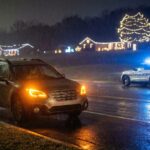Whether a car accident occurred due to distracted driving, an icy spot on the road, or speeding, there’s usually a clear reason. In some accident cases, it’s harder to identify this reason than in others. Accident reconstruction helps all parties involved definitively determine how and why the accident happened. Finding out more about accident reconstruction, including the technologies involved and how car accident lawyers use these results, helps you understand its importance.
What Is Accident Reconstruction?
Experts who are trained in accident reconstruction use scientific techniques to recreate a car accident. By analyzing the forensic details and physical limitations of the scene, these experts determine what happened and how it happened. Accident reconstruction makes it easier to figure out which party was at fault and the reason the accident occurred.
For example, say a car skidded off the road and into a nearby fence. The driver blames ice on the road or a sharp turn without a posted warning sign. Accident reconstruction specialists analyze road conditions, measure the degree of the turn, and study the vehicle’s skid marks on the pavement to recreate the incident.
After careful analysis, they determined that the vehicle was going faster than the posted 35 miles per hour, causing the driver to lose control and not make the proper turn to avoid the fence. By looking into the details and using forensics techniques to accurately recreate the scene, it’s easier to precisely determine why the accident happened and who is at fault.
How Does Accident Reconstruction Work?
Accident reconstruction experts use a variety of analytical and forensics techniques to recreate how an accident happened. The types of techniques, data, and evidence they have available to utilize in the re-creation depend on the type of accident that occurred. For example, in a one-vehicle accident, they may analyze the car, the road, and its surroundings. However, in a head-on collision accident, they’ll analyze both cars as well as the environment surrounding the accident scene.
When analyzing the vehicle, the experts investigate advanced vehicle safety features if possible, including forward-collision warnings or lane departure warnings. If these warnings were activated before the collision, it shows the driver may not have had complete control of the vehicle before the accident occurred. Vehicle damage is analyzed to determine how and where the car was hit.
Additionally, experts look at the road’s curvature, speed limit, skid marks, or other markings that indicate where the driver may have lost control. They can use complex mathematical equations and computer programs to better understand how the accident occurred and why and how the damage or injuries were sustained.
These experts may also analyze the police report, the drivers’ statements on what happened, and photos of the scene to accurately recreate what happened. However, if possible, experts usually prefer to analyze the scene and vehicles in person to determine the cause of the accident.
What Is Accident Reconstruction Used on?
Experts use accident reconstruction techniques on a variety of accidents when they need to pinpoint the cause. By re-creating the accident from the end back to the beginning, they construct an accurate timeline of the events. This methodology is used for many types of incidents, including:
- Car accidents.
- Motorcycle accidents.
- Plane crashes.
- Truck accidents.
- Bridge collapses.
- Crane failures.
When the cause of an accident is unknown or two parties don’t agree on the reason it occurred, accident reconstruction can help determine what happened to solve the disagreement.
Who Hires Accident Reconstruction Specialists?
Police officers, forensic specialists, or lawyers may enlist the help of accident reconstruction specialists to determine the details of an accident. Auto injury lawyers who represent clients who can’t afford to pay their auto accident medical expenses may need an accident re-created to prove it wasn’t their client’s fault. With accident reconstruction, the lawyer may solidify the case against the other driver, winning medical expense compensation for their client.
Police may not know who to issue a citation to in an accident if they’re unsure of how the accident occurred. For example, a driver may have been driving under the influence (DUI) of a controlled substance when they crashed into another vehicle. An accident reconstruction specialist can analyze the scene and help the police determine who should be cited for the accident.
Forensic specialists may be tasked with figuring out why an accident occurred to identify potential faults in construction or engineering. For example, if a bridge collapses, accident restoration specialists are brought in to figure out what caused the collapse.
Then, forensic specialists analyze the accident re-creation so they can provide specific reasons the accident occurred to the bridge engineers. Once the problem is identified, engineers may fix structural mistakes in construction and design improved structures that are safer.
The Technology Behind Accident Reconstruction
Accident reconstruction experts implement several techniques and technologies to accurately analyze an accident scene. The types of technologies they use depend on the specific accident and the evidence they have to work with but may include:
- Crash data recorders: Vehicles may have crash data recorders, commonly referred to as “black boxes” installed. Experts may analyze the data on these recorders to find out what happened moments before the accident.
- Event data recorders: These recorders are similar to crash data recorders and provide experts with information on the driver or pilot’s actions right before an accident occurred.
- Computer-aided design (CAD) programs: Once an expert has analyzed the scene, they can recreate it digitally with a 3-D drawing computer program. CAD programs allow experts to animate the accident scene to show their theory of what happened.
- Forensic animation: Similar to CAD programs, forensic animation computer programs also allow these experts to tell the story of what appears to have happened in a crash. Using forensic animation, experts may more easily prove their theory and why they believe the events unfolded as they did.
Police may use the tools provided by accident reconstruction specialists to prove who was at fault and to issue citations. Injury attorneys may use animation or recorders in their testimony to prove their clients weren’t at fault for the accident and are entitled to compensation for medical bills.
Accident reconstruction specialists are vital in determining who was at fault for an accident and why the accident occurred. By re-creating the events of the accident scene, injury lawyers may prove their clients deserve compensation, the police may determine which driver should be issued a citation, and engineers may analyze what went wrong with their designs.







